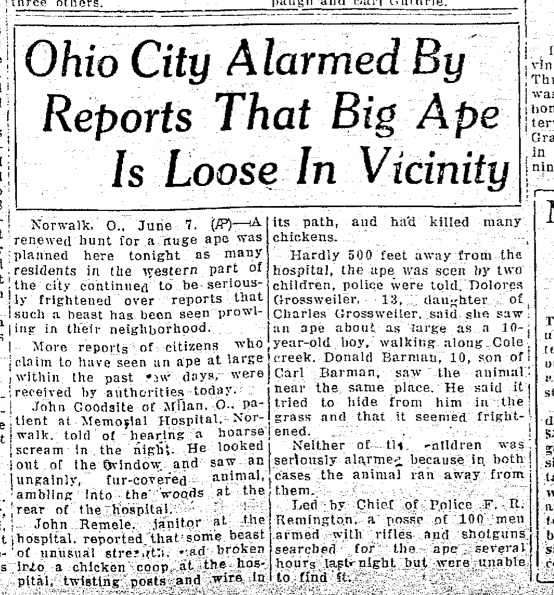Ohio Ape: 1930
Posted by: Loren Coleman on February 25th, 2012
Logansport Press, Logansport, Indiana
Sunday, June 8, 1930

About Loren Coleman
Loren Coleman is one of the world’s leading cryptozoologists, some say “the” leading living cryptozoologist. Certainly, he is acknowledged as the current living American researcher and writer who has most popularized cryptozoology in the late 20th and early 21st centuries.
Starting his fieldwork and investigations in 1960, after traveling and trekking extensively in pursuit of cryptozoological mysteries, Coleman began writing to share his experiences in 1969. An honorary member of Ivan T. Sanderson’s Society for the Investigation of the Unexplained in the 1970s, Coleman has been bestowed with similar honorary memberships of the North Idaho College Cryptozoology Club in 1983, and in subsequent years, that of the British Columbia Scientific Cryptozoology Club, CryptoSafari International, and other international organizations. He was also a Life Member and Benefactor of the International Society of Cryptozoology (now-defunct).
Loren Coleman’s daily blog, as a member of the Cryptomundo Team, served as an ongoing avenue of communication for the ever-growing body of cryptozoo news from 2005 through 2013. He returned as an infrequent contributor beginning Halloween week of 2015.
Coleman is the founder in 2003, and current director of the International Cryptozoology Museum in Portland, Maine.










An ape breaking into a henhouse and killing chickens is a strange detail. You know, this made me think of all the shorts and movies made in the 1930s that had big, violent gorillas in them. I think the Three Stooges came up against one, and there was of course King Kong and his even more intriguing little brother, Mighty Joe Young. This subject would make an interesting paper, or even book, all by itself.
An ape breaking into a henhouse and killing chickens, or into a pigpen and killing pigs, or into a corral and killing goats, horses, cattle, keep going…is nothing unusual to anyone who’s read a lot of sasquatch reports.
If this animal is real, it’s taking a lot of meat. If one is looking for an ecological analogue, “bear” seems closest.